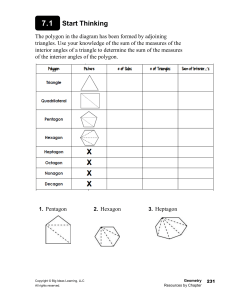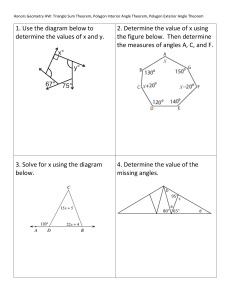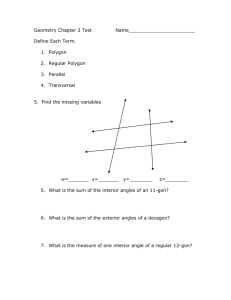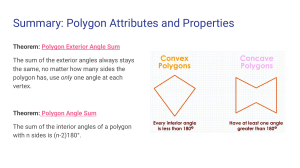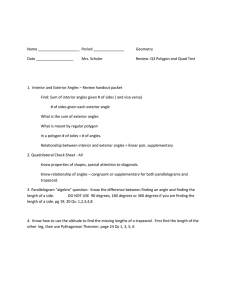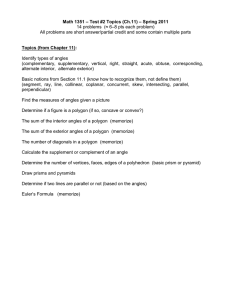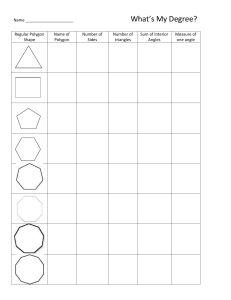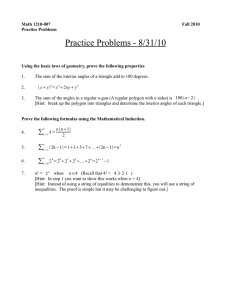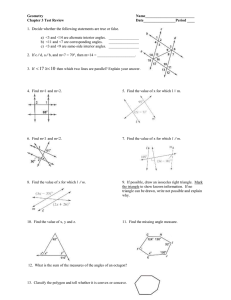Polygon Angles Lesson Plan: Interior & Exterior Sums
advertisement
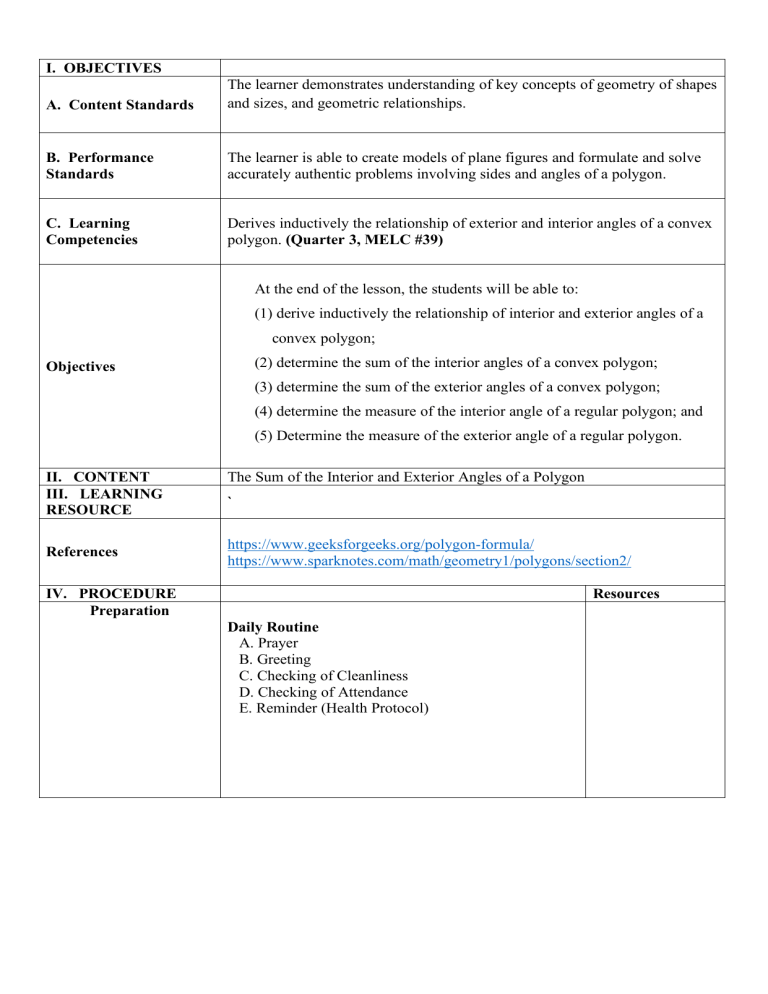
I. OBJECTIVES A. Content Standards The learner demonstrates understanding of key concepts of geometry of shapes and sizes, and geometric relationships. B. Performance Standards The learner is able to create models of plane figures and formulate and solve accurately authentic problems involving sides and angles of a polygon. C. Learning Competencies Derives inductively the relationship of exterior and interior angles of a convex polygon. (Quarter 3, MELC #39) At the end of the lesson, the students will be able to: (1) derive inductively the relationship of interior and exterior angles of a convex polygon; (2) determine the sum of the interior angles of a convex polygon; Objectives (3) determine the sum of the exterior angles of a convex polygon; (4) determine the measure of the interior angle of a regular polygon; and (5) Determine the measure of the exterior angle of a regular polygon. II. CONTENT III. LEARNING RESOURCE References IV. PROCEDURE Preparation The Sum of the Interior and Exterior Angles of a Polygon ` https://www.geeksforgeeks.org/polygon-formula/ https://www.sparknotes.com/math/geometry1/polygons/section2/ Resources Daily Routine A. Prayer B. Greeting C. Checking of Cleanliness D. Checking of Attendance E. Reminder (Health Protocol) INTRODUCTION The teacher will ask the following and will randomly call students to share their answers in the class. I. Identify whether the following figures is a POLYGON or NOT a POLYGON. POLYGON NOT A POLYGON II. WHY are the following figures polygons? Answers: - closed figures - straight sides - has at least three sides - planes NOTE: A plane is a flat surface that extends forever in two dimensions, but has no thickness. III. WHY are the following figures not polygons? Answers: - have curve lines - NOT all sides are straight lines NAMING POLYGONS ACCORDING TO THE NUMBER OF SIDES Cut Outs PPT DEVELOPMENT The teacher will introduce the lesson using PPT constructivism approach. She will guide the students on how to determine the sum of the interior angles of a polygon inductively. To do this, she will first ask the students to follow the given instructions on each example, and let them realize a pattern that could help them in solving for the sum of the interior angles of a polygon. Example 3: Afterwards, the teacher will ask the students to determine the number of triangles formed on each polygon, and use this information in finding the sum of the interior angles of the given polygon. The teacher will then write on the board the following answers gathered from the students. Polygon No. of Sides Number of Triangles Formed Sum of the interior angles Triangle 3 1 1 x 1800 = 1800 Quadrilateral 4 2 2 x 1800 = 3600 Pentagon 5 3 3 x 1800 = 5400 Hexagon 6 4 4 x 1800 = 7200 Heptagon 7 5 5 x 1800 = 9000 Octagon 8 6 6 x 1800 = 1,0800 Nonagon 9 7 7 x 1800 = 1,2600 The teacher will then ask the following questions. (1) Have you observed any pattern in finding the sum of the interior angles of any given convex polygon?” (2) If so, what is it then? Possible answers of the students: (1) Yes (2) If we let the number of sides of any convex polygon be N, then we can represent the sum of the interior angles of any convex polygon as: (N - 2) x 1800 Teacher : Very Good! That is a very keen observation! The teacher will now then help the students to determine the sum of the exterior angles of any convex polygon inductively, and will call students randomly to share with the class their observations. After these observations, the teacher will then guide the students in discovering how to determine the measure of the interior and the exterior angles of a regular polygon. ENGAGEMENT Name the following polygons and find the sum of its interior angles. (1) (4) ASSIMILATION (2) (3) (5) Find the measure of the interior and exterior angles of the following polygons. (1) (2) (3) (4) (5) Wrap up Feedback / Assessment Closure/Reflection / Assignment V. REMARKS VI. REFLECTION A. No. of learners who earned at least 80% on the formative assessment B. No. of learners who require additional PPT Find the sum of the interior angles, and measure of each interior and exterior angle of a decagon. PPT Homework: PPT Given the following n-side polygons, find the following: (i) measure of each interior angle; (ii) measure of each exterior angle; (iii) sum of the interior angles of each polygon. (1) hendecagon (2) dodecagon activities for remediation C. Did the remedial lessons work? No. of learners who have caught up with the lesson. D. No. of learners who continue to require remediation E. Which of my teaching strategies worked well? Why did these work? F. What difficulties did I encounter which my principal or supervisor can help me solve? G. What innovation or localized materials did I use/discover which I wish to share with other teacher?
